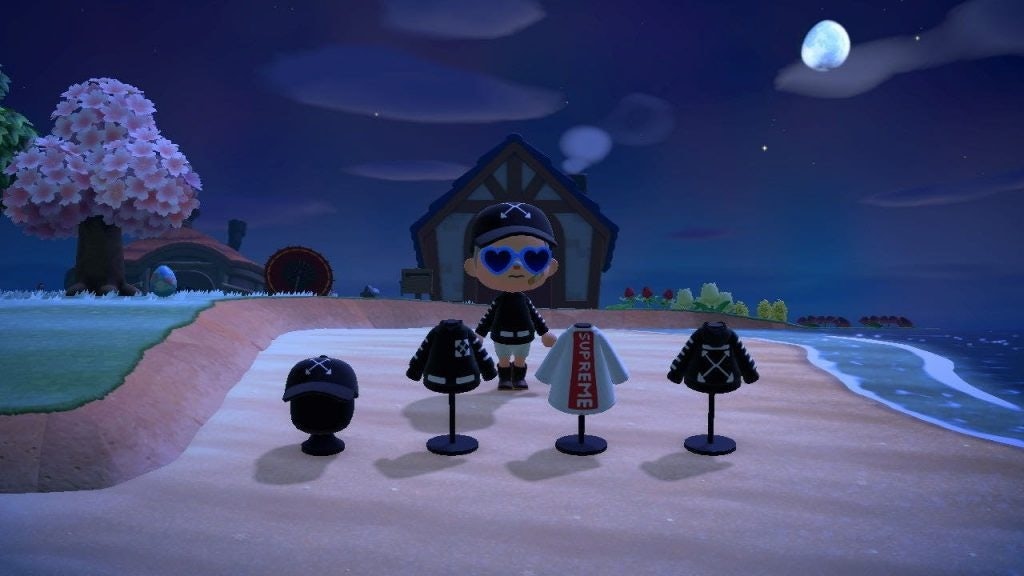On March 20, Nintendo released its widely anticipated Switch console game, Animal Crossing: New Horizons — and social media sites around the world have been awash with tips and updates on the gameplay experience ever since. On Instagram, the hashtag ‘animalcrossing’ has attracted over 2 million related posts, including gameplay hacks, memes, and even cosplay.
The game itself is simple: Players build a life on a virtual island through social interactions, make currency with activities, pay off debts, and can even enjoy a Shangri-La-esque vacation. Fortuitously released during the global shutdown following COVID-19 when gamers have a surplus of time on their hands, it’s unsurprising that the Switch console sold out just days after its release.
Players can virtually visit each other’s islands in the game, which creates a sense of community that’s sadly now missing from the real world. As a result of these interactions, fashion fans have identified the game as a new platform for showcasing sartorial choices and design inspiration. The game’s creative customization feature allows them to turn their islands into unique identity symbols — from their chosen buildings and bedsheets to featured clothing and accessories.
Virtual fashion has become a key part of the gaming experience and is taking on real-world attributes. For example, on the social discussion forum Reddit, the “r/ACQR” community came about after people shared their creations through QR codes and, in turn, led to a virtual manufacturing line of unlimited designs and styles. By scanning these codes on Nintendo’s phone app, players can dress their characters in the downloaded graphics. While the game is currently classified as unofficial in China, there are always ways to obtain copies while approval is pending, and Jing Daily has taken a look at what exactly makes the game pertinent to the luxury fashion community.
Virtuality is the future#
From fast fashion to luxury, forward-thinking apparel companies have been collaborating with the gaming industry lately. In fact, esports and gaming have become a field that’s too lucrative for brands to ignore, and the global investment banking group Goldman Sachs predicted that virtual and augmented reality technologies will be worth more than 81 billion by 2025. Virtual opportunities provide a glimpse into the fashion industry’s future, and in light of the growing demand, fashion groups should continue to partner with gaming companies like Nintendo on offline clothing collections.

In the past, British luxury brand Burberry launched the mobile game B Bounce while Louis Vuitton tapped the market by collaborating with League Of Legends — a multiplayer game with over 100 million active global users. Even the chain store Forever 21 released a collection that featured the popular first-person shooter game Overwatch. And this April, Japanese casual wear brand Uniqlo released a T-shirt collection featuring graphic prints from Nintendo’s famed video game franchise Super Mario Bros on the game’s 35th anniversary.
And, considering how vigorously fans have embraced gaming fashions, it’s likely that consumers will only encourage the sector to further embrace the idea of digital customization in the future. The customization company PlatformE has been advancing the rollout of made-to-order products through virtual samples by using 3-D scanning and data analytics technology. The customization process of 3-D avatars can be tracked by simply clicking a button on your phone, making it one of the more accessible channels to date.

Streetwear is capturing players online#
Due to the visual language of Animal Crossing, brands with sleek graphics are faring best. According to Kyle Xu, a 27-year-old gamer who favors streetwear for his virtual character “Stig,” players across the platform tend to choose minimal designs like the Adidas logo, as its geometric pattern can be sketched easily by hand on the game’s virtual clothing drawing board.
“I made an Off White hoodie in the game because its signature patterns are easy to draw out... people can easily recognize what I’m going for,” said Xu. Brands have taken note that the younger generation’s fashion tastes — both in the game and in reality — are that less equals more. And as someone who owns multiple Yeezy products and other streetwear merchandise, Xu considers his virtual clothing designs an extension of his identity.
“I’m currently making more Supreme-inspired brand clothing because I want to be true to my first real-life streetwear collection,” he added. “When I visited the Supreme flagship store in California for the first time, their customer service was great, and I received free merchandise. This left a strong impression on me.”
As Jing Daily has previously reported, millennials and Gen Zers are looking for a holistic shopping experience — one that extends beyond just purchasing. A positive and social in-store experience can help brands stand out, and it will be reflected online through willing ambassadors.
Making luxury democratic#
Since fashion, like other industries, is currently at a standstill with store closures, canceled fashion weeks, and uncertain supply chains, there’s been a spike in demand for virtual fashion. By releasing exclusive virtual designs through in-game purchases, brands can win over a younger demographic and attract consumers with less disposable income. This gaming industry crossover will help increase overall revenue, but it will also help brands cultivate a more positive image with new consumers.
This type of brand promotion is more affordable in the virtual realm, but it’s just as important as offline marketing — perhaps more important. A meme of the game’s NPC character Isabelle has already gone viral because her outfit had similarities to a Gucci design. “Isabelle has been low-key flexing [an Internet term for showboating] on us this whole time,” said one Twitter user.
Just like in real life, the act of digitally flexing has become synonymous with streetwear. 20-year-old art student Roann Cordova, who attracted Internet fame from posting his Animal Crossing designs on “Subtle Asian Traits” (the world’s largest online Asian community), has already spotted a gap for the trendy apparel in the game. “With a lack of default streetwear in the game, I just started designing expensive clothes I wish I had in real life,” he explained.
As the industry shifts gears to tackle a new reality, digital innovations have been rising, and virtual fashion might soon be as valuable to consumers as their physical purchases.

